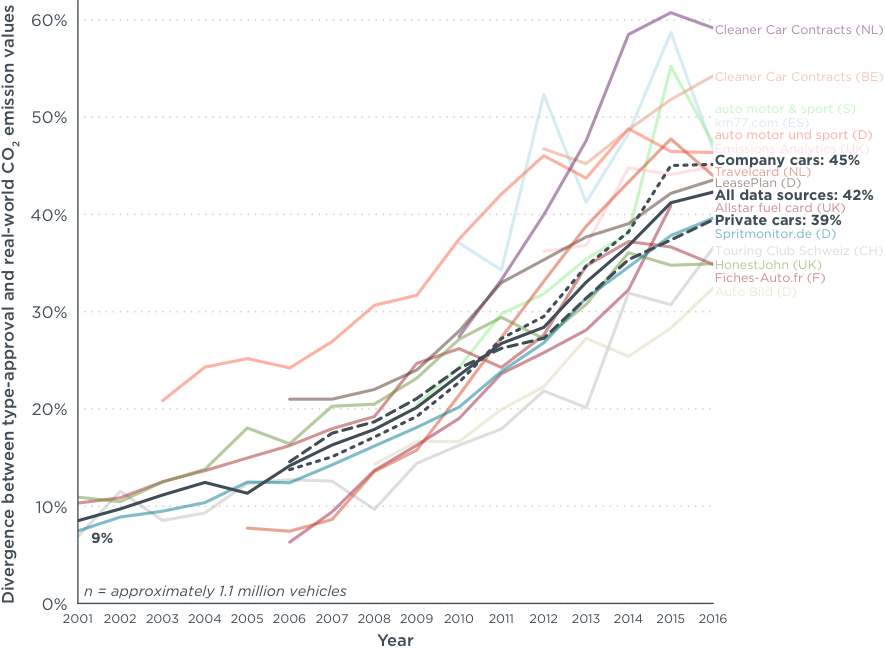Press release
Real-world vehicle fuel consumption gap in Europe at all-time high
Discrepancy between passenger vehicle type-approval test results and in-use fuel consumption and carbon dioxide (CO2) emissions at 42 per cent, with first indications of a possible slowdown in the growth of the gap.
The average gap between official fuel consumption figures and actual fuel use for new cars in the EU has reached 42 per cent, according to the latest update by the International Council on Clean Transportation (ICCT) to its on-going research into vehicle fuel consumption and CO2 emissions.
Since 2001, the discrepancy between official measurements of vehicle efficiency and actual performance of new cars in everyday driving has more than quadrupled—a discrepancy that translates into €400 per year in extra fuel costs for the average vehicle. As a result, less than half of the on-paper reductions in CO2 emission values since 2001 have been realized in practice.
A companion analysis by the ICCT indicates that similar gaps between official and real-world CO2 emissions exist in China, Japan, and the United States. “However, since 2001 Europe has seen the largest increase in the gap,” says Dr. Peter Mock, Managing Director of ICCT Europe.
This update, jointly prepared by the ICCT and the Netherlands’ Organisation for Applied Scientific Research (TNO), describes the increasing real-world efficiency gap using statistical analysis. “We analyzed data for more than 1.1 million vehicles from eight European countries, and all data sources confirm that the gap between sales-brochure figures and the real world has reached another all-time high,” says Uwe Tietge, a researcher at ICCT Europe and lead author of the study. “When we published our first study in 2013, the gap had widened over ten years from roughly 10 per cent to around 25 per cent. Now it has increased to 39 per cent for private cars, and 45 per cent for company cars.” For the first time, the update notes a slowdown in the rate of increase in the gap, in particular for company cars. “But it is too early to tell whether the gap will flatten off.” emphasizes Uwe Tietge.
The analysis draws on data from 14 different sources: the user websites spritmonitor.de (Germany), HonestJohn.co.uk (United Kingdom) and Fiches-Auto.fr (France), the fleet management and fuel card companies Travelcard (Netherlands), LeasePlan (Germany), Allstar fuel card (United Kingdom), and Cleaner Car Contracts (Belgium and Netherlands), the car and consumer magazines AUTO BILD (Germany), auto motor sport (Germany and Sweden), the vehicle testing organization Emissions Analytics (United Kingdom), the car website km77.com (Spain), and the car club TCS (Switzerland).
Manufacturers measure vehicle fuel consumption in a controlled laboratory environment. Since September 2017, a new test procedure, the Worldwide Harmonized Light Vehicles Test Procedure (WLTP), has to be followed for new vehicle types. From September 2018 onwards it will become mandatory for all new vehicles. The ICCT researchers expect that because the WLTP more accurately reflects real-driving conditions it will help cut the real-world gap approximately in half. “But even the new test procedure contains new loopholes that could permit the performance gap to increase again in the future,” warns Dr. Mock. “Further actions are therefore required, in particular on-road testing of fuel consumption and CO2 emissions under real driving conditions and a not-to-exceed limit for the real-world gap, as it already exists for air pollutant emissions today.”
The United States demonstrate how a comprehensive set of policy measures can help to contain the real-world gap. “In the U.S., independent surveillance testing of actual vehicles on the road has been standard practice for many years,” says Uwe Tietge. “It is no surprise that the increase in the real-world gap has been much lower in the U.S. than in Europe. In fact, the fuel consumption values communicated to consumers in the U.S. paint a very accurate picture of the average real-world fuel consumption.”
On November 8, the EU Commissioner for Climate Action and Energy, Miguel Arias Cañete, is expected to announce a regulatory proposal for reducing CO2 emissions of new cars and vans for the 2020–2030 time period. It remains uncertain whether the Commission’s regulatory proposal will also include policy instruments to tackle the discrepancy between official and real-world CO2 emission levels.
From laboratory to road: A 2017 update of official and “real-world” fuel consumption and CO2 values for passenger cars in Europe (PDF download)
From laboratory to road international: A comparison of official and real-world fuel consumption and CO2 values for passenger cars in Europe, the United States, China, and Japan (PDF download)


Contact: Dr. Peter Mock, Managing Director ICCT Europe, +49 (30) 847129-102, peter@theicct.org
